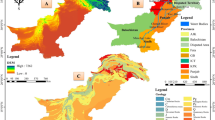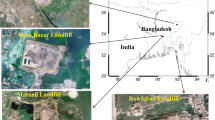Abstract
According to its high production and value, Akkar is considered as the second agricultural region in Lebanon. Groundwater constitutes the principal source of water in Akkar including drinking water of local inhabitants in Akkar. As such, the contamination of groundwater by organic pollutants can impact directly the population health. In this study, we evaluated the contamination status of groundwater in this region. Three classes of pesticides including 19 organochlorine (OC) pesticides, 8 organophosphorus (OP) pesticides, and 6 organonitrogen (ON) pesticides were monitored in 15 groundwater samples collected from different villages on the Akkar plain. Samples were extracted by using solid phase extraction (SPE) and analyzed by gas chromatography coupled with mass spectrometry (GC-MS). The results showed high contamination of Akkar groundwater by OCs with levels that can reach 58.9 μg/L. They were detected in the majority of the sample and represent 95–100% of ∑pesticides. Our results showed the recent use of these molecules with an average level of 0.3 and 0.39 μg/L for ∑HCHs and DDTs, respectively. Their concentrations were higher than those observed in the same region in 2014 and other regions elsewhere. OPs were also detected at high levels and among them, methylparathion was the predominant OP detected (44.6 μg/L). For ONs, lower levels were measured in all samples with a mean value of 5.6 μg/L. As a conclusion of this work, groundwater on the plain of Akkar was remarkably contaminated by the studied pesticides; indefinitely, more efforts should be taken to manage the pesticide use in this region, assess, and reduce their effects on human health. In the future, the application of organic farming can be a great solution to the groundwater contamination problem.





Similar content being viewed by others
References
Aly N, El-Gendy K (2015) Impact of parathion exposure on some biochemical parameters in rabbit as a non target organism. Alexandria Journal of Medicine 51:11–17
Awasthi N, Ahuja R, Kuma A (2000) Factors influencing the degradation of soil-applied endosulfan isomers. Soil Biol Biochem 32:1697–1705
Baroudi M, Bakkour H, Halwani J, Taha S, El-Osmani R, Mouneimne AH (2012) Determination of pesticide, nitrates and nitrites level in groundwater of Akkar plain in north Lebanon. J Appl Sci Res 8:4663–4667
Bhalerao TS, Puranik PR (2007) Biodegradation of organochlorine pesticide, endosulfan, by a fungal soil isolate, Aspergillus niger. International Biodeterioration & Biodegradation 59:315–321
Dabrowski J, Peall S, Reinecke A, Liess M, Schulz R (2002) Runoff-related pesticide input into the Lourens River, South Africa: basic data for exposure assessment and risk mitigation at the catchment scale. Water Air Soil Pollut 135(1–4):265–283
Dai G, Liu X, Liang G, Han X, Shi L, Cheng D, Gong W (2011) Distribution of organochlorine pesticides (OCs) and poly chlorinated biphenyls (PCBs) in surface water and sediments from Baiyangdian Lake in North China. J Environ Sci 23:1640–1649
DAR-IAURIF (2004) Schéma d’Aménagement du Territoire Libanais, Rapport Final, L0215-RPT-10 REV A 11 de 233)
Directive Cadre Européen (1998) On the quality of water intended for human consumption Brussels, Belgium: Council Directive 98: 83
El-Osmani R, Net S, Dumoulin D, Baroudi M, Bakkour H, Ouddane B (2014a) Solid phase extraction of organochlorine pesticides residues in groundwater (akkar plain, north Lebanon). International Journal of Environmental Research 8:903–912
El-Osmani R, Net S, Dumoulin D, Bigan M, Ouddane B, Baroudi M (2014b) Experimental design approach to the optimization of pesticides extraction from water. Anal Methods 6:6514–6521
Eqani SA, Malik RN, Mohammad A (2011) The level and distribution of selected organochlorine pesticides in sediments from River Chenab, Pakistan. Environ Geochem Health 33:33–47
European Union, Common position (EC) 12767/97 (1997) Adopted by the council on 16 December 1997 with a view to the adoption of council directive on the quality of water intended for human consumption Inter-institutional file 95/0010 (SYN)
Fujii Y, Ito Y, Harada KH, Hitomi T, Koizumi A, Haraguchi K (2012) Comparative survey of levels of chlorinated cyclodiene pesticides in breast milk from some cities of China, Korea and Japan. Chemosphere 89:452–457
Hajjar M, Noura J (2011) Occurrence of organochlorine pesticide residues in groundwater and soil from Syrian coastal area. Agric Biol J N Am 2:488–492
Halwani J, Ouddane B, Baroudi M, Wartel M (1999) Contamination par les nitrates des eaux souterraines de la plaine d’Akkar au Liban du Nord. Cahiers d’études et de recherches francophones/Santé 9:219–223
Hostetler KA, Thurman EM (2000) Determination of chloroacetanilide herbicide metabolites in water using high-performance liquid chromatography-diode array detection and high-performance liquid chromatography/mass spectrometry. Sci Total Environ 248:147–155
Hu Y, Qi S, Zhang J, Tan ZJ, Wang Y, Yuan D (2011) Assessment of organochlorine pesticides contamination in underground rivers in Chongqing, Southwest China. J Geochem Explor 111:47–55
Huang GX, Sum JC, Wang S, Du HY, Zhi BF, Chen HC, Chen X, Jing JH (2008) Elementary research of organochlorine pesticide in groundwater of pearl river delta. Journal of Agro-Environment Science 4:037
IARC (2006) World Health Organization, International Agency for Research on Cancer, overall evaluations of carcinogenicity to humans, list of classifications, vol 1–115 available at http://monographs.iarc.fr/ENG/Classification/latest_classif.php
International Agency for Research on Cancer (IARC) (1979) Monographs on the evaluation of carcinogenic risk of chemicals in humans. Lyon 20:155–178
Jiang YJ, Yan J (2010) Effects of land use on hydrochemistry and contamination of karst groundwater from Nandong Underground River System, China. Water Air Soil Pollut 210:123–141
Jones KC, De Voogt P (1999) Persistent organic pollutants (POPs), state of the science. Environ Pollut 100:209–221
Kong DY, Zhu ZL, Shi LL, Shan ZJ, Cai DJ (2004) Effect of pesticides on groundwater under sweet-potato-based cropping systems in northern China. Journal of Agro-Environment Science 23(5):1017–1020
Kuranchie-Mensah H, Atiemo SM, Palm LM, Blankson-Arthur S, Tutu AO, Fosu P (2012) Determination of organochlorine pesticide residue in sediment and water from the Densu river basin, Ghana. Chemosphere 86:286–292
Li J, Zhang G, Qi S, Li X, Peng X (2006) Concentrations, enantiomeric compositions, and sources of HCH, DDT and chlordane in soils from the Pearl River Delta, South China. Sci Total Environ 372:215–224
Li BH, Ren ZY, Chen HH, Cao XJ, Liu F (2007a) Residues of organochlorine pesticides in shallow groundwater of agricultural region in Taihu Basin. Journal of Agro-Environment Science 5(5):1714–1718
Li L, Liu F, Qian C, Jiang S, Zhou Z, Pan C (2007b) Determination of organophosphorus pesticides in Lycium barbarum by gas chromatography with flame photometric detection. J AOAC Int 90:271–276
Li X, Gan Y, Yang X, Zhou J, Dai J, Xu M (2008) Human health risk of organochlorine pesticides (OCs) and polychlorinated biphenyls (PCBs) in edible fish from Huairou Reservoir and Gaobeidian Lake in Beijing, China. Food Chem 109:348–354
Liu LH, Shu LC, Chen XH, Oromo T (2010) The hydrologic function and behavior of the Houzhai underground river basin, Guizhou Province, southwestern China. Hydrogeol J 18:509–518
Ministry of energy and water (2010) Lebanese government (resolution No. 2, date 09/03/2012)
Ministry of environment/UNDP (2011) Climate change vulnerability and adaptation agriculture, Lebanon’s second national communication
MoA (2007) Project of agriculture census 2005. Ministry of Agriculture
MoE (2001) Lebanon State of Environmental Report. Ministry of Environment
Net S, Rabodonirina S, Ben Sghaier R, Dumoulin D, Chbib C, Tlili I, Ouddane B (2015) Distribution of phthalates, pesticides and drug residues in dissolved, particulate and sedimentary phases in freshwater system. Sci Total Environ 521-522:152–159
Prado G, Bhalli JA, Marcos R (2009) Genotoxicity of heptachlor and heptachlor epoxide in human TK6 lymphoblastoid cells. Mutation Research/Genetic Toxicology and Environmental Mutagenesis 673:87–91
Qiu X, Zhu T, Yao B, Hu J, Hu S (2005) Contribution of dicofol to the current DDT pollution in China. Environmental Science & Technology 39:4385–4390
Rissato SR, Galhiane MS, Ximenes VF, De Andrade RM, Talamoni JL, Libânio M, De Almeida MV, Apon BM, Cavalari AA (2006) Organochlorine pesticides and polychlorinated biphenyls in soil and water samples in the Northeastern part of São Paulo State, Brazil. Chemosphere 65:1949–1958
Salem DM, El Sikaily A, El Nemr A (2014) Organochlorines and their risk in marine shellfish collected from the Mediterranean coast, Egypt. The Egyptian Journal of Aquatic Research 40:93–101
Sankararamakrishnan N, Sharma AK, Sanghi R (2005) Organochlorine and organophosphorous pesticide residues in ground water and surface waters of Kanpur, Uttar Pradesh, India. Environ Int 31:113–120
Singh KP, Malik A, Mohan D, Sinha S (2005) Persistent organochlorine pesticide residues in alluvial groundwater aquifers of gangetic plains India. Bull Env ContamToxicol 74:162–169
United Nations Environment Programme (UNEP) (2004) Initial actions to be considered on becoming a party of the Stockholm convention on persistent organic pollutants. United Nations Environment Program, Geneva
USEPA (2007) Drinking water standards and health advisories table. Available at https://www3.epa.gov/region9/water/drinking/files/dwsha_0607.pdf
USEPA (2009) National primary drinking water regulations. Available at http://water.epa.gov/drink/contaminants/index.cfm
USEPA (2011) Pesticides industry sales and usage: 2006 and 2007 market estimates. Available at www.epa.gov/opp00001/pestsales/07pestsales/market_estimates2007.pdf
Wong MH, Leung AO, Chan JK, Choi MP (2005) A review on the usage of POP pesticides in China, with emphasis on DDT loadings in human milk. Chemosphere 60:740–752
World Health Organization (2011) Agents classified by the IARC monographs, volumes 1–101
Yang H, Xue B, Yu P, Zhou S, Liu W (2010) Residues and enantiomeric profiling of organochlorine pesticides in sediments from Yueqing Bay and Sanmen Bay, East China Sea. Chemosphere 80:652–659
Yang T, Zhao B, Hou R, Zhang Z, Kinchla AJ, Clark JM, He L (2016) Evaluation of the penetration of multiple classes of pesticides in fresh produce using surface-enhanced Raman scattering mapping. J Food Sci 81:11
Zhao YY, Pei YS (2012) Risk evaluation of groundwater pollution by pesticides in China: a short review. Procedia Environmental Sciences 13:1739–1747
Zhao Z, Zhang L, Wu J, Fan C (2009) Distribution and bioaccumulation of organochlorine pesticides in surface sediments and benthic organisms from Taihu Lake, China. Chemosphere 77:1191–1198
Zheng X, Liu X, Liu W, Jiang G, Yang R (2009) Concentrations and source identification of organochlorine pesticides (OCs) in soils from Wolong Natural Reserve. Chin Sci Bull 54:743–751
Zhou R, Zhu L, Yang K, Chen Y (2006) Distribution of organochlorine pesticides in surface water and sediments from Qiantang River, East China. J Hazard Mater 137:68–75
Acknowledgements
The authors are grateful for the funding support of the PHC CEDRE Project, CPER CLIMBIO project, and the association AZM & SAADE (Lebanon) which provided a PhD scholarship for Chaza Chbib.
Author information
Authors and Affiliations
Corresponding author
Additional information
Responsible editor: Hongwen Sun
Rights and permissions
About this article
Cite this article
Chaza, C., Sopheak, N., Mariam, H. et al. Assessment of pesticide contamination in Akkar groundwater, northern Lebanon. Environ Sci Pollut Res 25, 14302–14312 (2018). https://doi.org/10.1007/s11356-017-8568-6
Received:
Accepted:
Published:
Issue Date:
DOI: https://doi.org/10.1007/s11356-017-8568-6




